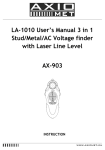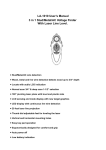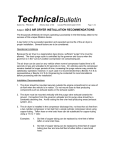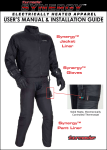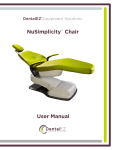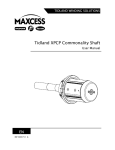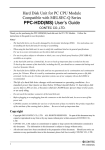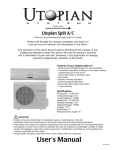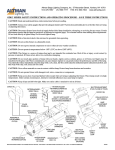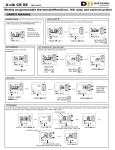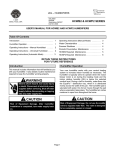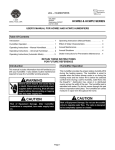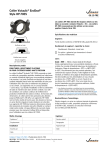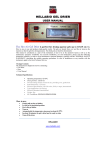Download LA-1010 User`s Manual 3 in 1 Stud/Metal/AC
Transcript
LA-1010 User’s Manual 3 in 1 Stud/Metal/AC Voltage Finder With Laser Line Level. ● Stud/Metal/AC wire detection ● Wood, metal and live wire detection-detects wood up to 3/4” depth ● Locate with audio LCD indication ● Normal scan 3/4” & deep scan 1-1/2” selection ● 180” pivoting laser plane with level and plumb vials ● LCD sensing and mode display with new target graphics ● LED display with continuous live wire detection ● 20 foot laser line projection ● Thumb dial adjustable feet for leveling the laser ● Vertical and horizontal mounting holes ● Easy key pad operation ● Ergonomically designed for comfort and grip ● Auto power off ● Low battery indication 1 SAFETY INSTRUCTIONS: Failure to follow warnings may result in bodily injury. The following warnings must be followed to avoid injury: • DO NOT remove warning labels. • DO NOT use optical tools such as a transit to view laser beam. Serious eye injury could result. • DO NOT project the laser beam directly into the eyes of others. • DO NOT stare directly at the laser beam. • DO NOT project laser beam onto a reflective surface. • DO NOT operate around children, or allow children to operate. • DO NOT disassemble the laser. • Always turn off laser when the tool is not in use. IMPORTANT: Read all instructions prior to operating the unit and DO NOT remove any labels from the tool. The unit produces a straight line on the same surface on which the tool is placed. Any reflection of the line on another surface should be considered reference. Introduction: z The unit uses electronic signals to locate the position of studs, joints or live AC wires through dry wall and other common wall materials. Once the edge of the stud has been detected, the unit LCD display gives visual and audio indications that allow you to easily pinpoint the stud’s edge position. A pencil line allows you to quickly note the location of the stud edges. z The unit generates a laser plane vertically and pivoting 90 degree clockwise or counterclockwise to generate a laser straight line. 2 z The unit provides automatic calibration for metal and wood stud modes, auto shut off and heavy duty ABS construction. z Detection mode is selected by keypad function – metal and wood stud. Default mode is wood stud detection. Mode should be selected before “on” key is pressed. Battery Replacement Open the battery door on back of unit and connect a 9-volt battery to clip. Place battery back into case and snap battery door on. It is recommended to replace with a new 9-volt battery when low battery indicator is on. Calibration: Calibrate the unit on wall before scanning for wood or metal stud. Note: While calibrating, the unit must not be placed directly over a stud, dense material such as metal, wet or newly painted areas, as this will prevent the unit from calibrating properly. If this is done over wood or metal stud, the unit will give no indication when moved away from the area. Move to a different location and try again. Illustration 1 Hold the unit flat against the surface, making firm contact. Press and hold the “On” button. All indicators on the LCD are displayed while the unit goes through its’ 3 second calibration cycle. When unit is calibrated, a beep will sound and the LCD will indicate (illustration 1). 3 ILLUSTRATION-2 ILLUSTRATION-3 USAGE: Detecting Wood Studs Wood Stud detection is set by default when the unit is on. 1. Slide the unit across the surface in a straight line. The closer the unit is to the stud the more bars will be shown, as illustration 2. When the stud edge is detected the Wood indicator and the edge bar will be shown, as illustration 3 and the unit will sound a repeating beep. 2. Use the indicator line to mark the stud edge. 3. Continue sliding past the stud. When the indicator turns off and the unit stops beeping, the other edge has been detected. 4. Double check stud location by coming back from the other direction. Make additional markings. 5. The midpoint of the marks indicates the stud center Illustration-4 Detecting Metal Studs 1. Press “Metal” button once and the LCD will be as shown on illustration 4. Press & keep holding the “On” button all the time during the stud detection 2. Repeat the procedures 1-5 as described in” Detecting Wood Stud”. 4 Detecting Live Wires: The Live Wire Detection feature is always on and the “Live Wire” icon will be displayed on the LCD. When a Live Wire is detected, the red live wire LED indicator will be on. Static electricity charges that can develop on drywall and other surfaces will spread the voltage detection area many inches to each side of the actual electrical wire. To aid in locating the wire position, scan holding the unit 1/2 inch away from the wall surface or place your other hand on surface approximately 12 inches from sensor. Warning: shielded wires or live wires in metal conduits, casings, metallized walls or thick, dense walls will not be detected. Always turn AC power off when working near wiring. The unit is designed to detect 110 volts (for USA version) and 230 volts for (European version) AC in live electrical wires. It will also detect the presence of live wires having greater than 230 volts. Adjustment Feet: The adjustment feet allow the leveling of the Laser line on the horizontal or vertical surfaces. Cautions on Operating: You should always use caution when nailing, cutting or drilling in walls, ceilings and floors that may contain wiring or pipes near the surface. Always remember that studs or joints are normally spaced 16 inches or 24 inches apart and are 1-1/2 inches in width. To avoid surprises, be aware that anything closer together or of a different width may be an additional a stud, joist or firebreak. IMPORTANT SAFETY NOTICE: Insure proper detection of live wires ALWAYS hold the unit in the handle area only. Grasp between fingers and thumb while maintaining contact with your palm. 5 Conventional Construction Doors and windows are commonly constructed with additional studs and headers for added stability. The unit detects the edge of these double studs and solid headers and emits and holds an audio signal as it crosses over them. Surface Differences Wallpaper—there will be no difference in the function of the stud sensor on surfaces covered with wallpaper or fabric unless the coverings contain metallic foil or fibers. Plaster and Lath — unless the plaster and lath is exceptionally thick or has metal mesh in it, there will be no problem with the unit functioning properly. Ceiling or Textured Surfaces—When dealing with a rough surface such as a sprayed ceiling, use a piece of cardboard when scanning the surface. Run through the calibration technique described earlier with the piece of cardboard between the stud sensor and the surface. Also, it is particularly important in this application to remember to keep your free hand away from the unit. Specifications Utilizing the procedure of scanning and marking from two sides, the unit will find the stud center with 1/8” accuracy for wood and 1/4” accuracy for metal. When measuring a wood or metal stud, it is recommended that the unit to be used at 33-55% relative humidity. Battery: 9 volt Operating Temperature: +20º to +120ºF (-7ºC to +49ºC) Storage Temperature: -20ºF to +150ºF (-29ºC to +66ºC) Laser diode: 650nm class IIIA Laser accuracy: 1/2” at 20 feet Length of projected Laser Line: up to 20 feet 6








